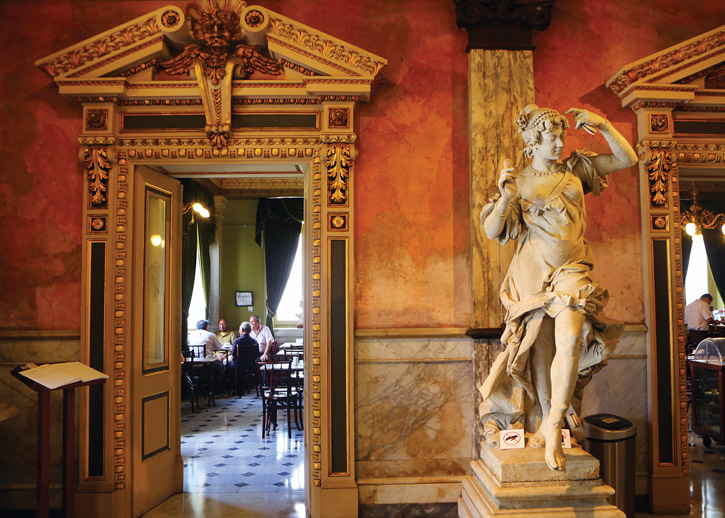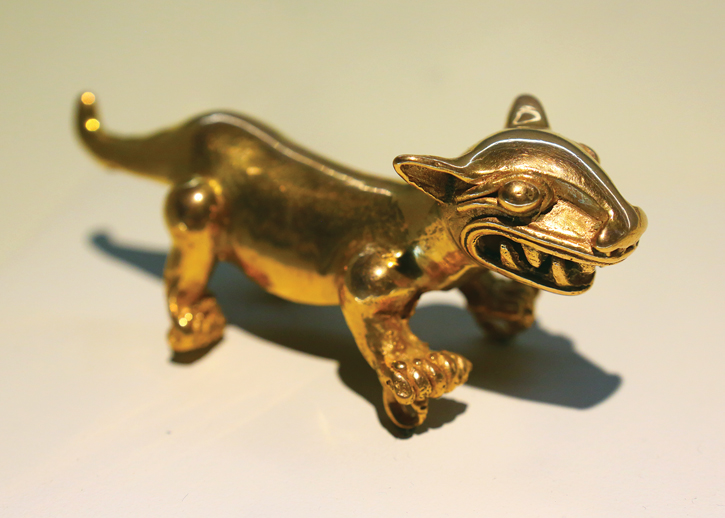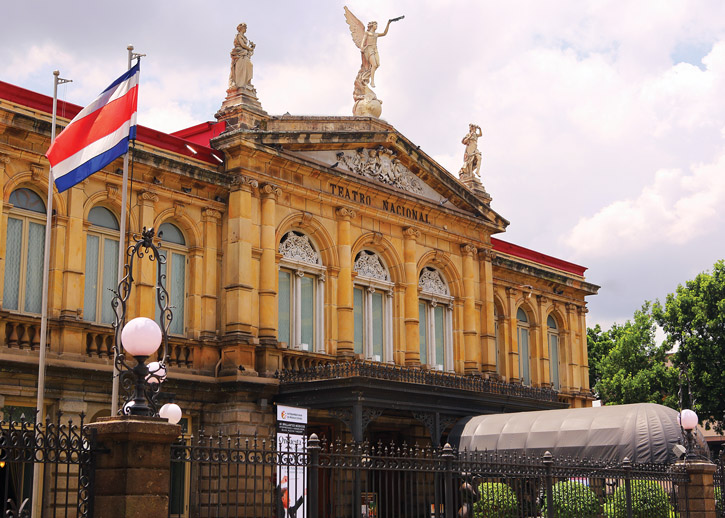San José’s unofficial focal point is the Plaza de la Cultura, bordered by Calles 3 and 5 and Avenidas Central and 2. Musicians, jugglers, and marimba bands entertain the crowds. Travelers gather on the southwest corner to absorb the colorful atmosphere while enjoying a beer and food on the open-air terrace of the venerable Gran Hotel, fronted by a little plaza named Parque Mora Fernández. Note too the historic Cine Diversiones (Calle 5, Ave. Central/2), with a beautiful metal filigree facade.
The Costa Rican Tourist Board has a tiny tourist information office in the Centro de Conservación (Ave. Central, Calles 1/3, 9am-5pm Mon.-Fri.), 50 meters (165 feet) northwest of the plaza.

The Teatro Nacional, San José’s architectural pride and joy, gleams after a recent restoration. Photo © Christopher P. Baker.
Guided tours (tel. 506/2243-4223, 1-15 people, $60) are given with 48 hours’ notice; bring identification for entry.

The Museo del Oro Precolombino contains a splendid collection of pre-Columbian gold and jade indigenous ornaments and artifacts. Photo © Christopher P. Baker.
The nation’s architectural showpiece, the Teatro Nacional (National Theater, Ave. 2, Calles 3/5, tel. 506/2010-1110, ticket office tel. 506/2010-1111, 9am-4pm Mon.-Sat., guided tours $7), on the south side of Plaza de la Cultura, is justifiably a source of national pride. The theater was conceived in 1890, when a European opera company featuring the prima donna Adelina Patti toured Central America but was unable to perform in Costa Rica because there was no suitable theater. Jilted, the ruling cafeteleros (coffee barons) voted a tax on coffee exports to fund construction of a theater, and craftspeople from all over Europe were imported. It was inaugurated on October 21, 1897, with a performance of Faust by the Paris Opera.
Outside, the classical Renaissance facade is topped by statues (they’re replicas; the originals are inside) symbolizing Dance, Music, and Fame; note the figures of Beethoven and Spanish dramatist Calderón de la Barca to each side of the entrance. Inside, the vestibule, done in pink marble, rivals the best of ancient Rome, with allegorical figures of Comedy and Tragedy, stunning murals depicting themes in Costa Rican life and commerce, and a triptych ceiling supported by six-meter-tall (20-foot-tall) marble columns topped with bronze capitals; a ceiling mural to the rear by Italian artist Aleardo Villa shows an allegorical coffee and banana harvest.

The statues symbolizing Dance, Music, and Fame atop Teatro Nacional are replicas. Look for the originals inside the building, Photo © Christopher P. Baker.
Art and good taste are lavishly displayed on the marble staircase, with its gold-laminated ornaments sparkling beneath bronze chandeliers and in the upstairs foyer. A grandiose rotunda, painted in Milan in 1897 by Arturo Fontana, highlights the three-story auditorium, designed in a perfect horseshoe and seating 1,040 in divine splendor. The auditorium floor was designed to be raised to stage level by a manual winch so the theater could be used as a ballroom.
Excerpted from the Tenth Edition of Moon Costa Rica.